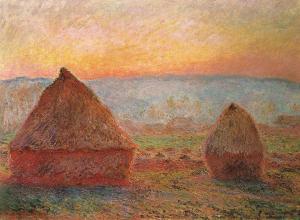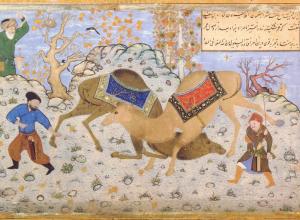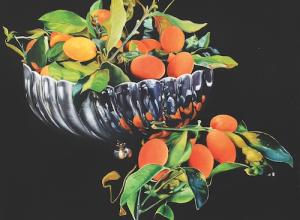
Painter Bob Ross making a painting demonstration in Fairbanks, Alaska, Circa mid-to late 70's. License
Bob Ross was an American painter and art instructor known for his contagiously cheerful demeanor— and his “happy little trees.” Born in Florida in 1942, Ross grew up with a fondness for nature. At the age of 18, he joined the Air Force, which soon became the unassuming origin of Ross’ interest in painting, as he would take art classes while stationed in Alaska.
Continuing to study art on his own, Ross began to sell the works he created, using the snowy, barren Alaskan landscape as inspiration. Eventually, the painter made enough profit off these sales and was able to retire from the military.
Back in Florida, Ross worked as an art tutor and instructor, leading to the creation of his half-hour instructional television show, The Joy of Painting. The first episode aired in 1983 on public television stations across the United States and ran up until 1994, one year before Ross’ death.
The formatting is simple— each episode starts with a blank canvas, and Ross walks the audience through the tools and techniques used to create a landscape masterpiece. It’s marketed as an episodic painting course, with Ross emphasizing that anyone, even those who have never held a paintbrush, can follow along.
He lists the supplies needed, like his infamous knives and two-inch paintbrushes, as well as the material and size of the canvas and the specific colors used— titanium white and van dyke brown, to name a few.
In each episode, Ross also explains the most effective brushstrokes to cover the canvas, such as making tiny x’s with the bristles, and will even mention how to dip the tools into the colors. The only caveat— he goes through everything pretty quickly. However, with the convenience of online reruns, the artist-to-be can now pause and rewind if something is missed.
The rarity of The Joy of Painting can be found right in its name. The show helps to foster confidence, as well as a love for art, within those following along. Starting on a blank canvas can be a daunting task, as any “wrong” movement holds the power to ruin the final piece, but Ross reassures his artists that where they place something is where it belongs.
Ross also encourages people to take risks and take authority over their own paintings by often saying “it doesn’t matter” and “you can do anything you want to do with this.” Again, this may also be overwhelming for brand new artists to have so many options, but the low stakes helps people to find confidence within themselves to follow their own paths.
And, for viewers who are not following the art instruction, there is still magic to be found in every episode. Ross’ calming demeanor and positive notes about the “happy little trees” and “happy mistakes” can come across as therapeutic. With an abundance of reruns, many put the show on in the background as means of decompressing and reducing anxiety levels.
Regardless of your preferred television viewing, The Joy of Painting serves a purpose for everyone.






















![DEl Kathryn Barton [Australian b. 1972] the more than human love , 2025 Acrylic on French linen 78 3/4 x 137 3/4 inches 200 x 350 cm Framed dimensions: 79 7/8 x 139 inches 203 x 353 cm](/sites/default/files/styles/image_5_column/public/ab15211bartonthe-more-human-lovelg.jpg?itok=wW_Qrve3)


